Did you know 52% of American adults take multivitamins regularly? Yet, many find it hard to pick the right ones. With over 75% of people looking for affordable options, finding effective and cost-conscious multivitamins is a challenge.
The truth is: not all budget-friendly multivitamins are created equal. Price is important, but there are three key things to look for. First, check if the vitamins have 100% Daily Value (DV) percentages. This ensures they are effective.
Second, choose USP-verified products. This means they have been tested for safety and accuracy. Third, pick a multivitamin that matches your age, gender, or health goals. For example, a young athlete needs different nutrients than an older woman.
Pharmacists say affordable doesn’t mean inferior if you know what to look for. By focusing on quality and avoiding misleading ads, you can get good nutrition without spending too much.
Key Takeaways
- Daily Value percentages above 100% ensure core vitamin adequacy
- USP verification guarantees ingredient accuracy and purity
- Demographic-specific formulas address unique nutritional needs
- Compare cost per serving instead of just the bottle price
- Avoid products with more than 300% DV for fat-soluble vitamins
Why Multivitamin Quality Matters on a Budget
Finding good affordable multivitamin options is more than just looking at prices. It’s about getting the nutrients your body needs. Let’s explore why cheap options might not be worth it.
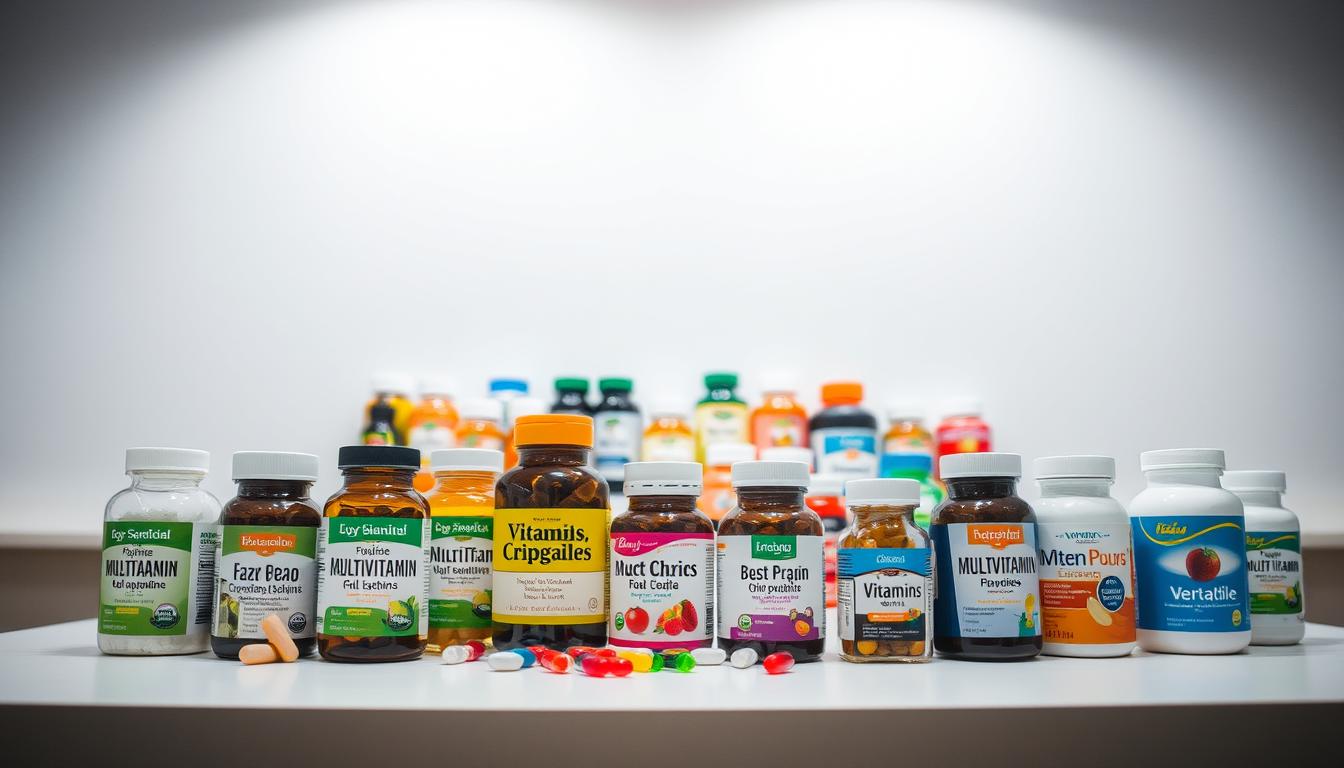
The Price-Quality Balance
Many cheap supplements use low-cost ingredients to save money. For example, calcium carbonate is cheaper than calcium citrate but absorbs less. A 2023 study showed 22 out of 25 melatonin gummies had wrong labels. This shows that low cost doesn’t always mean true value.
RDA Compliance vs. Cost Cutting
Some cheap brands give less than half the daily vitamin D you need to save money. Here are three signs of quality in affordable multivitamin options:
- 100% Daily Value for water-soluble vitamins
- At least 50% DV for harder-to-absorb minerals
- Third-party testing seals (like USP or NSF)
Long-Term Health Implications
Poor absorption can harm your health. Synthetic folic acid is cheaper than methylfolate but not everyone can use it well. This leads to nutritional gaps that grow over time.
Nutrient Absorption Differences
Here are some common cost-cutting measures and their effects:
| Ingredient | Cheap Form | Premium Form |
|---|---|---|
| Vitamin E | dl-alpha-tocopherol | d-alpha-tocopherol |
| Magnesium | Magnesium oxide | Magnesium glycinate |
| Iron | Ferrous sulfate | Ferrous bisglycinate |
Premium ingredients cost more but offer better absorption. Clinical trials show they can be 300% more effective. This makes affordable multivitamin options a smart health choice.
How to Choose the Best Budget Multivitamin: Key Steps
Choosing a cost-effective multivitamin involves two key steps. First, understand your body’s needs. Second, look for verified nutritional values. We’ll guide you through these steps to make smart choices without spending too much.
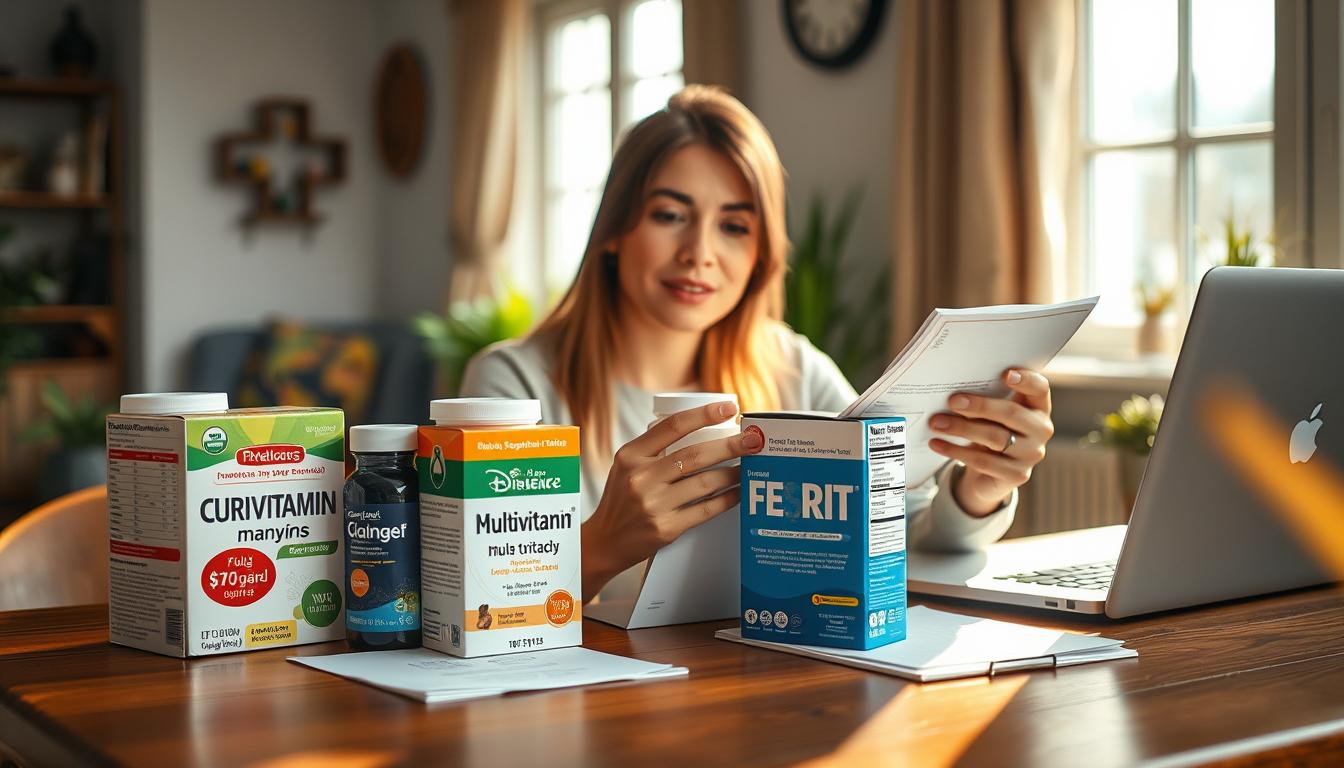
Step 1: Assess Personal Nutritional Gaps
Begin by figuring out what your diet is missing. Nearly 95% of Americans don’t get enough vitamin D, and 40% lack magnesium, says NHANES. For 3-5 days, track your meals with:
- Mobile apps like MyFitnessPal for easy tracking
- Journaling your food with portion notes
- Checking against USDA dietary guidelines
Using Dietary Recall Methods
Pay special attention to nutrients often missing in budget multivitamins. Calcium, vitamin D, and potassium are often lacking. If you don’t eat much dairy or fatty fish, look for these in your multivitamin.
Step 2: Verify Essential Nutrients
Compare your findings with FDA Daily Values (DV). Budget multivitamins often lack important nutrients:
| Nutrient | Minimum DV% | Common Gaps |
|---|---|---|
| Vitamin D | 20% | Only 15% in most store brands |
| Calcium | 15% | Often excluded in basic formulas |
FDA-Recommended Daily Allowances
Look for these label details:
Avoid products with more than 100% DV for fat-soluble vitamins (A, D, E, K). They can build up in your body. Water-soluble vitamins like C can safely reach 150% DV.
Pro tip: Check serving sizes. Some brands list 2 tablets as one serving to seem cheaper. Calculate the actual daily cost before buying.
Critical Vitamin Checklist
Creating a multivitamin plan that’s affordable is all about smart choices. Finding the best value multivitamin means knowing which nutrients offer the most bang for your buck. Let’s explore the key vitamins that balance cost and effectiveness.
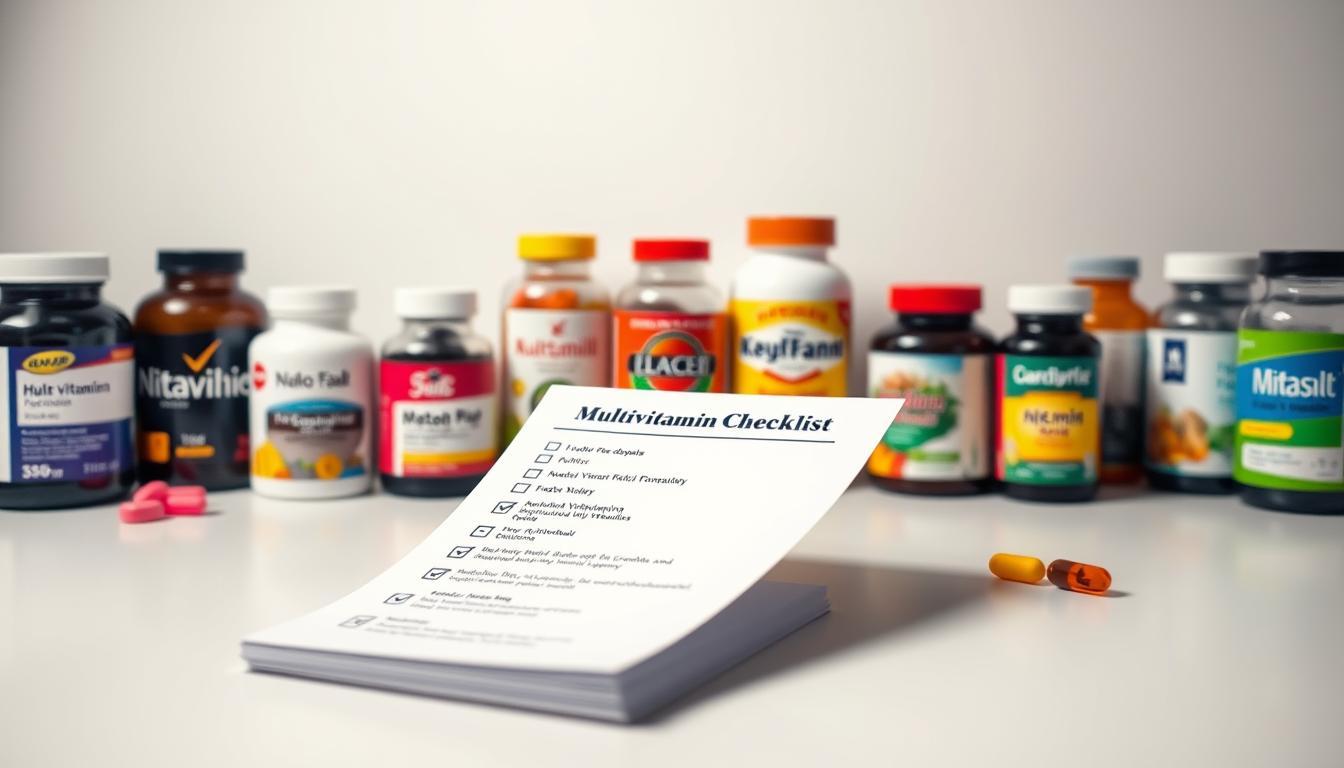
Fat-Soluble Essentials
These vitamins need fats to absorb and stay in your body longer. Focus on these two important ones:
Vitamin D3 (Cholecalciferol)
Choose D3 over D2—it’s 27% more effective at keeping blood levels stable, as Source 3’s research shows. Many affordable options now include 1,000–2,000 IU of D3. It’s vital for bone health and immune function.
Vitamin K2 Inclusion
Look for MK-7 form of K2, which works well with D3. Together, they help direct calcium to bones, not arteries. A 2023 study found that this combo improved calcium use by 38% compared to D3 alone.
“The D3-K2 combination is a cost-effective duo in preventive health.”
Water-Soluble Must-Haves
These vitamins need daily replenishment. Choose forms that are both potent and affordable:
Vitamin C Forms Compared
Most budget options use ascorbic acid, but mineral ascorbates (like calcium ascorbate) are gentler. Here’s a cost comparison:
| Form | Cost Per 500mg | Bioavailability |
|---|---|---|
| Ascorbic Acid | $0.03 | Medium |
| Mineral Ascorbate | $0.11 | High |
Ascorbic acid is cheaper, but those with sensitive stomachs might prefer pricier buffered forms. Source 3 advises against more than 1,000mg for most adults, to avoid wasting money.
The best value multivitamin focuses on the right forms and doses of key vitamins. Use this checklist with our mineral guide (Section 5) for a full cost-benefit analysis.
Mineral Must-Haves in Affordable Options
Smart shoppers know minerals are key in multivitamins. But, not all forms are good for budget formulas. Calcium is vital for bones, and iron boosts energy.
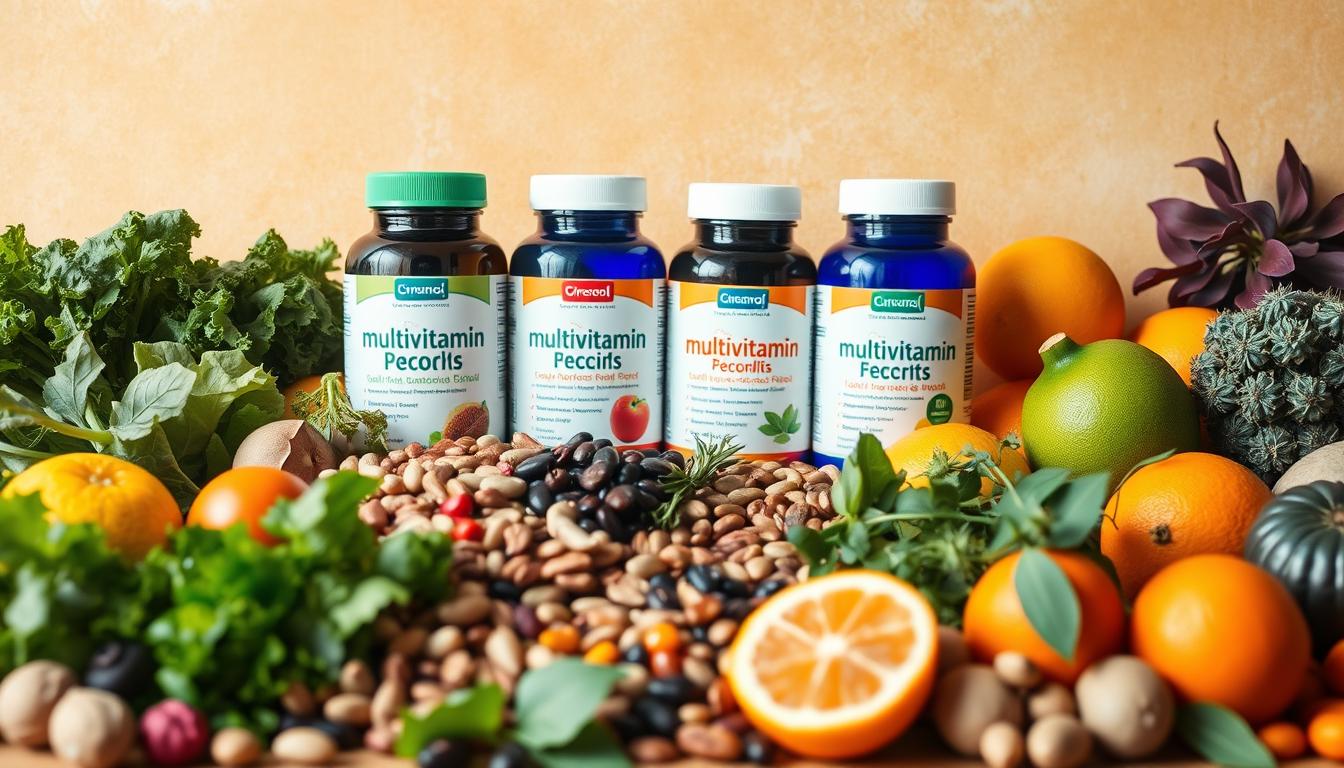
Calcium Sources and Bioavailability
Many cheap multivitamins use calcium carbonate because it’s cheaper. But, it needs stomach acid to be absorbed well. This can be a problem for older adults or those on acid reducers.
Calcium carbonate vs citrate
- Carbonate: Contains 40% elemental calcium, best taken with meals
- Citrate: 21% elemental calcium but absorbs better without food
A 2023 study found citrate absorbs 2.5x better in low-acid conditions. While citrate is pricier, some budget brands now offer it in moderate doses. This balances cost and effectiveness.
Iron Content Considerations
Iron is a challenge in economical multivitamin choices. Most cheap formulas use plant-based iron. But, they need smart formulation to avoid stomach problems.
Heme vs non-heme iron
| Type | Absorption Rate | Common Sources |
|---|---|---|
| Heme | 15-35% | Animal products (rare in multivitamins) |
| Non-heme | 2-20% | Ferrous sulfate, gluconate |
Vegans or vegetarians should look for formulas with vitamin C. It helps absorb non-heme iron better. Also, avoid products with too much iron, as it can cause constipation.
“Budget multivitamins can meet mineral needs through smart formulation, but consumers should verify both quantity and form.”
Here are three tips for choosing minerals:
- Check calcium form based on your digestion needs
- Confirm iron type matches your dietary preferences
- Verify mineral amounts stay within 100-150% DV
Decoding Supplement Facts Panels
Reading supplement labels is more than just looking at the bottle. To choose a low-cost multivitamin selection wisely, you need to understand Supplement Facts panels. Let’s explore what’s important in these labels.
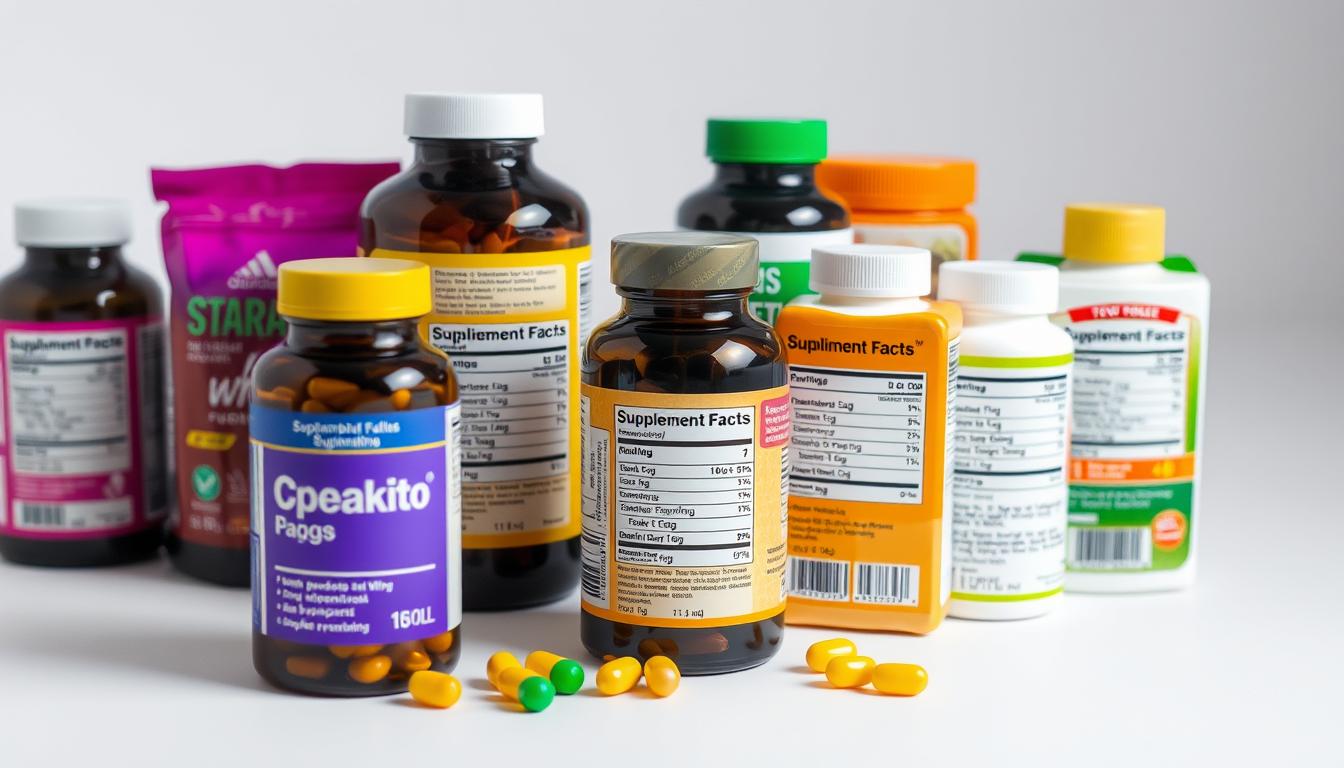
Understanding “% Daily Value”
The % Daily Value (DV) tells you how much a nutrient contributes to your daily needs. Most vitamins aim for 100% DV. But, there are exceptions.
- Calcium often appears at 20-30% DV due to tablet size limits
- Magnesium may show lower percentages to avoid digestive issues
100% DV Exceptions
Some nutrients go beyond 100% DV for a reason. Vitamin D often exceeds 100% DV because many people lack it. Here’s a table showing common variations:
| Nutrient | Typical %DV | Safe Upper Limit |
|---|---|---|
| Vitamin C | 100% | 2000mg |
| Vitamin B12 | 4167% | No established limit |
| Zinc | 91% | 40mg |
Ingredient List Red Flags
Be cautious of these cost-cutting additives that might lower quality:
- Artificial colors (FD&C Blue No. 2)
- Hydrogenated oils
- Excessive fillers
Magnesium Stearate Concerns
This common flow agent is in 72% of budget multivitamins, says ConsumerLab. While safe in small amounts, high amounts may:
- Reduce nutrient absorption
- Trigger sensitivities in some users
For stress management through nutrition, consider adding targeted supplements to your multivitamin.
Third-Party Testing Verification
Looking for an optimal budget multivitamin? Independent testing is key. Third-party certifications ensure supplements are safe and effective. They do this without making the product too expensive.
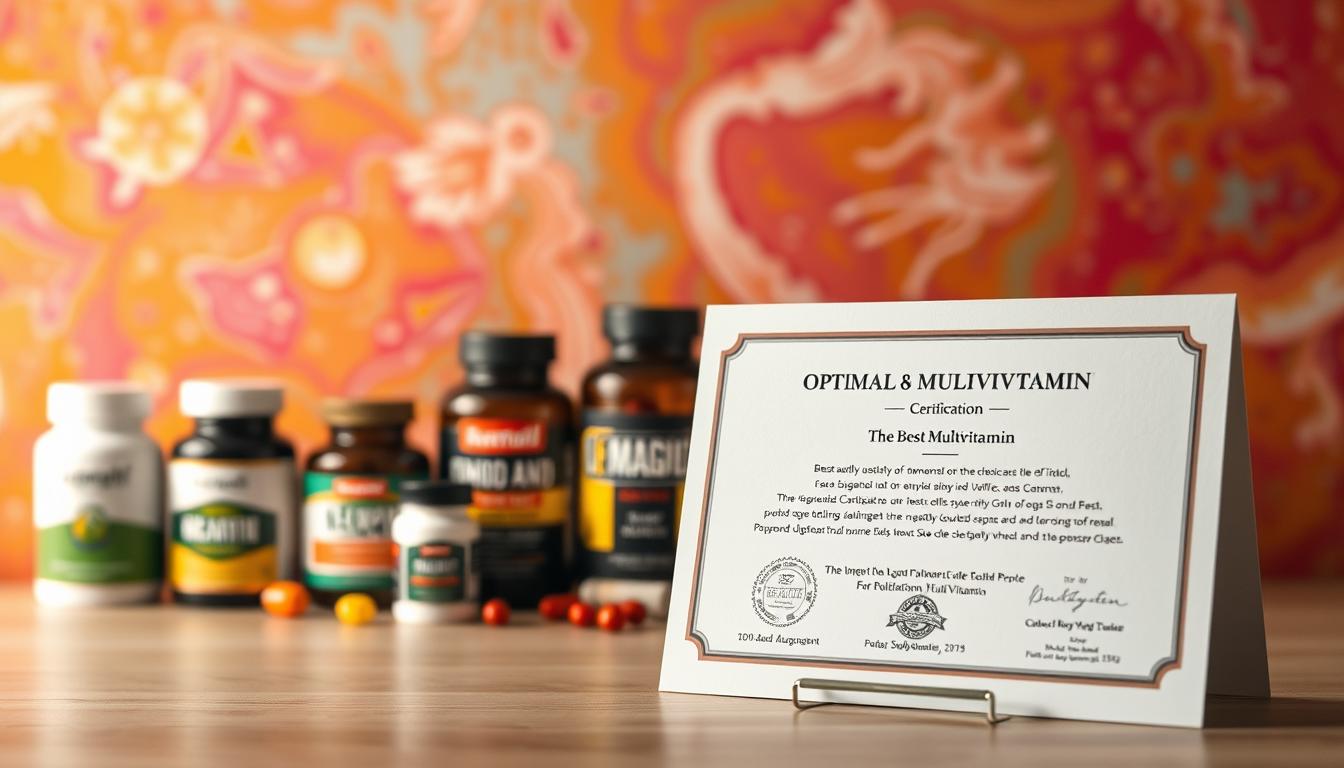
USP Certification Process
The U.S. Pharmacopeia (USP) mark means a multivitamin has been thoroughly tested. Manufacturers choose to have their products checked. They pay between $15,000 to $30,000 for each type of supplement.
Testing Parameters Explained
USP looks at three important things:
- Dissolution rate: Tablets must release nutrients in 30-45 minutes
- Ingredient purity: Checks for harmful substances like lead
- Potency accuracy: Makes sure the label is right within ±10%
Only 43% of budget multivitamins pass all USP tests. Many struggle with dissolution tests because of cheap ingredients that block nutrient absorption.
NSF International Standards
NSF certification is more than just quality checks. It’s a favorite among athletes and health enthusiasts. Their Certified for Sport program tests for 280+ banned substances.
Athlete-Approved Testing
NSF’s tests include:
- Heavy metal contamination checks
- Anabolic steroid detection
- Stimulant screening (e.g., DMAA, sibutramine)
| Certification | Key Focus | Ideal For |
|---|---|---|
| USP | Manufacturing standards | General consumers |
| NSF | Contaminant prevention | Athletes/Safety-focused users |
NSF-certified multivitamins are 15-20% pricier than non-certified ones. But they offer peace of mind against doping or heavy metal risks. Both certifications help find optimal budget multivitamins that are both affordable and reliable.
Formulation Types Compared
The type of your multivitamin affects its effectiveness and cost. Affordable multivitamin brands often use tablets to save money. But, vegetarian capsules might offer better results, even if they cost a bit more.
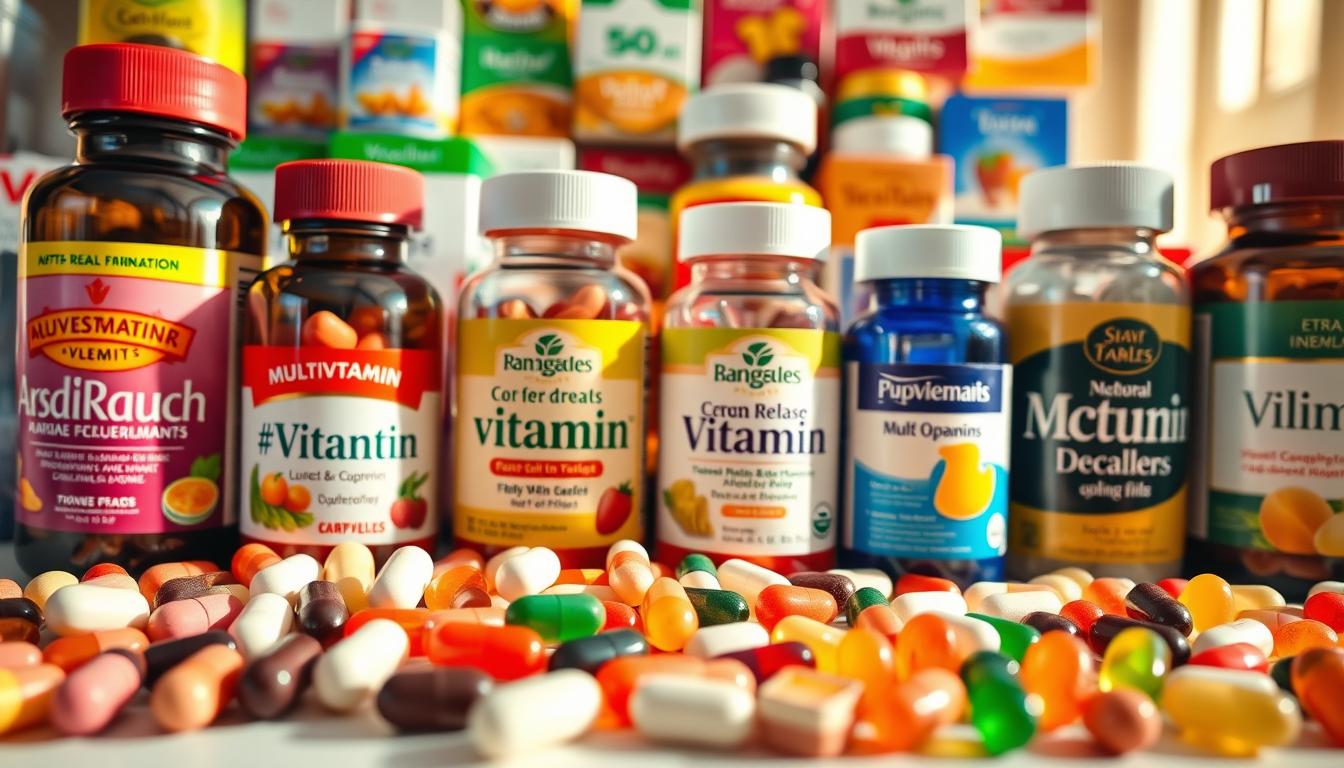
Tablet Compression Issues
Tablets are common because they’re cheap to make. But, they can be hard to break down. A study found 15% of tablets don’t dissolve in 30 minutes.
Digestibility Factors
Dense tablets might not dissolve well, which can be a problem for people with sensitive stomachs. A study in 2023 found that tablets absorb calcium 22% less than capsules in adults over 40.
Vegetarian Capsule Advantages
Plant-based capsules dissolve faster, which helps with nutrient absorption. They are about 10-15% more expensive than tablets. But, they protect nutrients from stomach acid.
Absorption Rate Studies
Studies show capsules release nutrients 40% faster than tablets. A clinical trial found that people taking capsules had 18% higher vitamin D levels after six months.
| Feature | Tablets | Capsules |
|---|---|---|
| Dissolution Time | 25-45 minutes | 8-12 minutes |
| Average Cost/Month | $4.50 | $5.20 |
| Nutrient Protection | Limited | Acid-resistant |
When looking for affordable multivitamin brands, focus on how well they work. Capsules might be a better choice in the long run, even if they cost more upfront.
Cost-Effective Purchasing Strategies
Getting the most value from multivitamins means looking at both how much you buy and when. Smart shoppers save money by using bulk discounts, choosing store brands, and timing their purchases. Let’s explore the smart way to shop for supplements.
Price Per Serving Calculation
Always check the price per serving instead of just the bottle size. Divide the total cost by the number of servings you take each day. For instance, a $20 bottle with 100 servings costs $0.20 per day. But a $15 bottle with 60 servings is $0.25 per day.
Kirkland Signature Example
Costco’s Kirkland Signature Multivitamin has 300 tablets for about $18. With two tablets a day, you get 150 servings for just $0.12 per day. This is much cheaper than buying single bottles at pharmacies, saving 40-60% a year.
Store Brand Comparisons
Big retailers now make high-quality store brands that are as good as national brands. CVS Health and Nature Made show how prices can vary:
| Brand | Tablet Count | Regular Price | Sale Frequency |
|---|---|---|---|
| CVS Health | 120 | $10.99 | Monthly BOGO 50% |
| Nature Made | 100 | $14.99 | Quarterly $3 Off |
CVS Health vs Nature Made
CVS Health often has Buy One, Get One 50% Off deals, making its price $8.24 per bottle. Nature Made keeps prices steady but has better mineral absorption. Buy during CVS’s sales to save money without losing out on nutrient absorption.
Pro Tip: Use store loyalty programs and manufacturer coupons together for even bigger discounts. Many stores offer special deals on budget-friendly multivitamins through their apps.
Top 7 Budget Multivitamin Picks
Finding good vitamins that are affordable is key. We looked at third-party tests and cost to find the best value. These options offer great nutrition without costing too much.
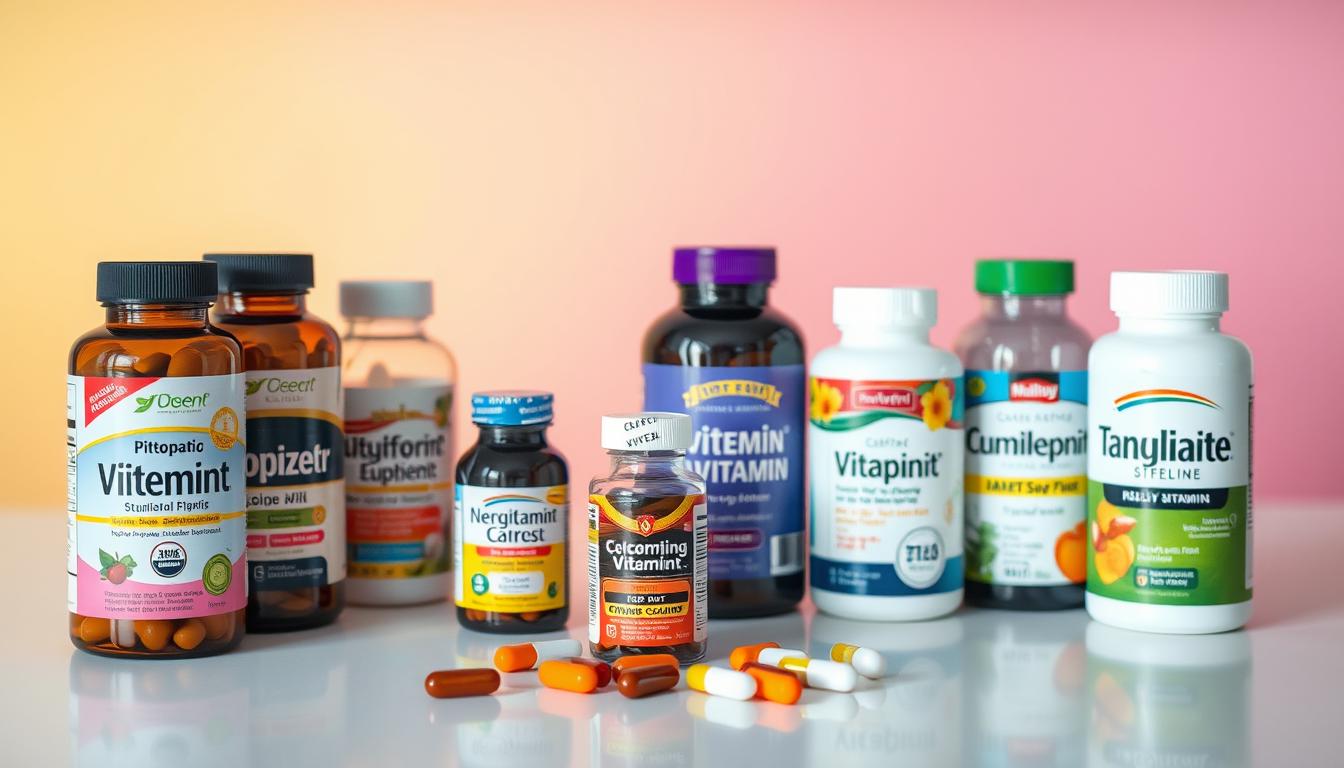
| Brand | Key Nutrients | Daily Cost | Special Features |
|---|---|---|---|
| Nature Made Multi for Him | 22 essentials including Zinc & Vitamin D | $0.17 | USP Verified |
| Centrum Silver Adults 50+ | Lycopene + 28 micronutrients | $0.23 | Age-specific antioxidants |
Nature Made Multi for Him
This men’s formula has 22 essential nutrients for just 17¢ a day. It has 100% DV of zinc for immune health and vitamin D3 for calcium absorption. Tests show it’s always potent.
Key nutrients: 22 essentials
It focuses on nutrients men often miss:
- Vitamin D (200% DV)
- Magnesium (50% DV)
- Vitamin B12 (417% DV)
Cost: $0.17/day
Buying in bulk can make it even cheaper. The simple packaging keeps costs down without sacrificing quality.
Centrum Silver Adults 50+
This formula is made for older adults. It has lycopene for prostate health and better vitamin B12 absorption. The tablets are also smaller for easier swallowing.
Age-specific formulation
It tackles common issues in older adults:
- 50% more vitamin D than standard formulas
- Reduced iron content (0mg)
- Added lutein for eye health
Lycopene inclusion
The 300mcg of lycopene per serving supports antioxidants for men over 50. Studies suggest it helps with heart health when eaten with a balanced diet.
Optimal Consumption Timing
When you take your multivitamin, it affects how well it works. Strategic timing is key to better nutrient absorption, which is more important with simpler, cost-effective multivitamins. Here are some science-backed tips to get the most from your daily multivitamin.
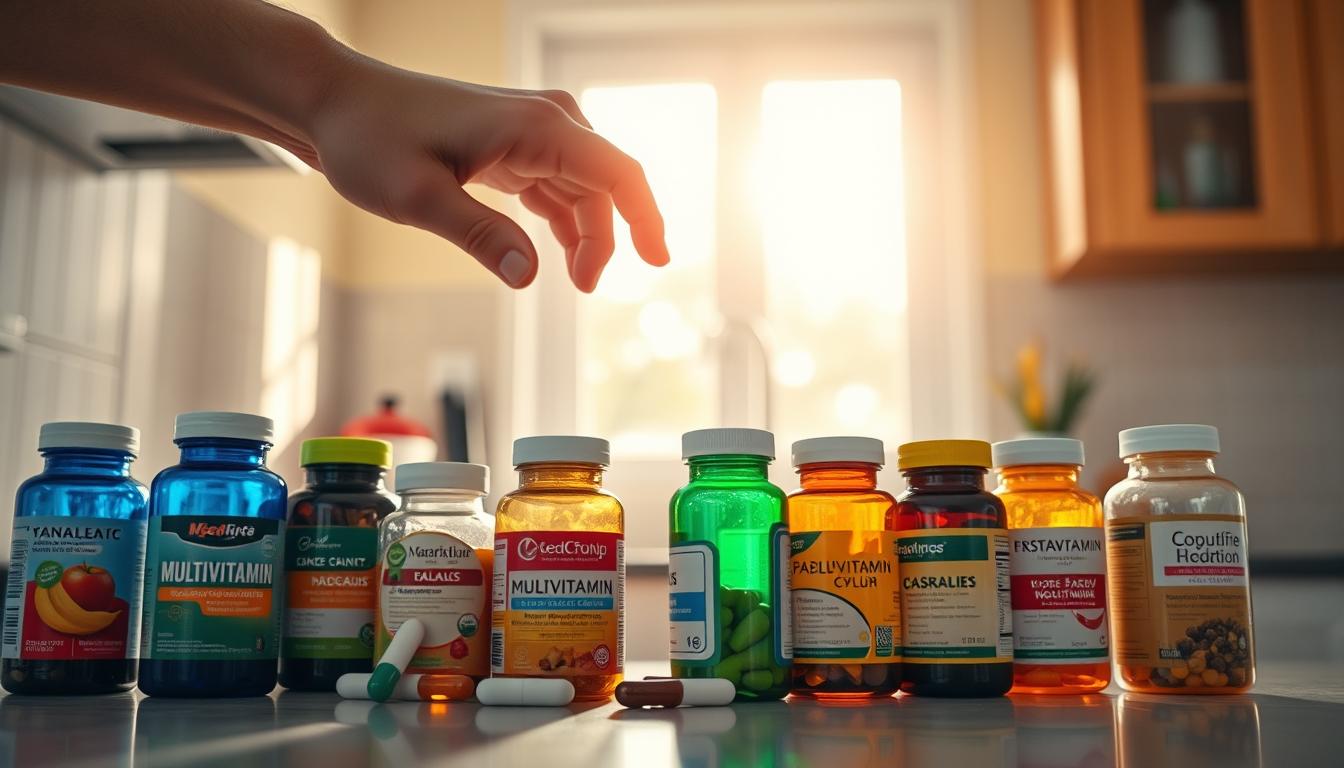
Morning vs Evening Dosing
Morning is the best time for most people, thanks to B vitamins like B12 and folate. These vitamins boost energy, matching our natural energy peaks after waking. A 2022 study showed a 18% increase in alertness with B-complex vitamins before 10 AM.
B Vitamin Energy Effects
Take water-soluble B vitamins with breakfast to:
- Fuel morning metabolic processes
- Reduce midday fatigue
- Prevent sleep disruptions from late-day dosing
Food Pairing Recommendations
Pair your multivitamin with meals that have healthy fats. This boosts nutrient absorption, which is vital for budget-friendly options.
Fat-Soluble Vitamin Intake
Vitamins A, D, E, and K need dietary fats to work right. Try taking them with:
- Avocado slices (5g fat per ounce)
- Almond butter (9g fat per tablespoon)
- Olive oil-dressed vegetables (7g fat per teaspoon)
This method helps with absorption, even in cheaper formulas. Studies show adding 3-5g of dietary fat can increase absorption by up to 32%.
Storage for Maximum Potency
Keeping your multivitamin effective is more than just buying a good one. Proper storage is key to getting the most out of your best value multivitamin. Heat, moisture, and light can all reduce its potency. Here’s how to keep your supplements safe from these enemies.
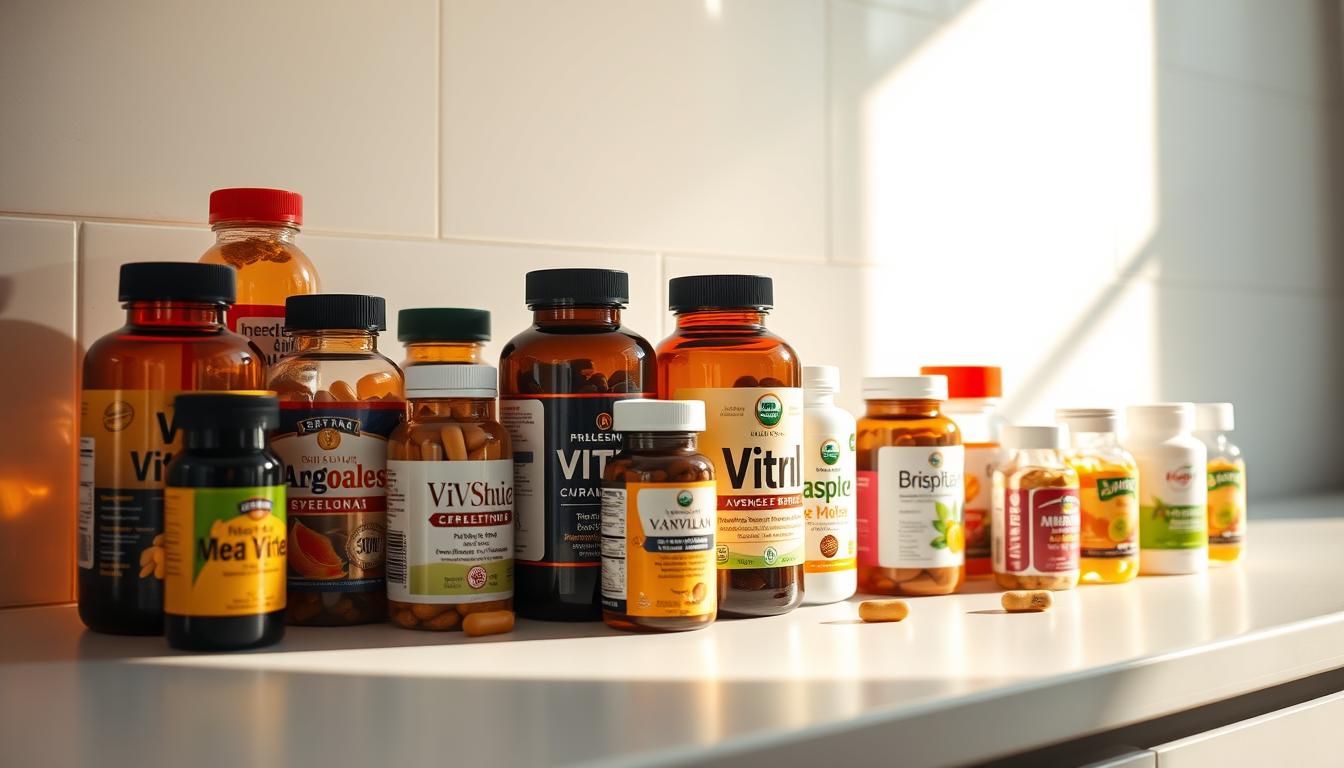
Humidity Control Techniques
Moisture is a big problem for vitamins. It makes tablets clump and speeds up chemical breakdown. Keep your multivitamin in its original container, with the lid closed tight. Store it in a cool pantry, not a steamy bathroom.
Silica Gel Packet Use
Those small packets saying “Do Not Eat” are very helpful. Silica gel pulls in extra moisture, helping to keep nutrients stable. Studies show vitamins stored with silica gel stay fresh 42% longer than those without.
Light Exposure Prevention
Sunlight can damage more than just labels. It breaks down vitamins like C and riboflavin. A study found clear bottles lose 35% more vitamin C in six months than dark ones.
UV Degradation Rates
Dark amber bottles block 97% of UV light. Clear packaging offers almost no protection. If your best value multivitamin is in clear packaging, move it to a dark jar. Or store it in a kitchen cabinet away from windows.
Health-Specific Formulations
When looking for economical multivitamin choices, your health matters a lot. Certain needs, like managing pregnancy or controlling blood sugar, need specific nutrients. We’ll look at how to find affordable options that are effective for these needs.
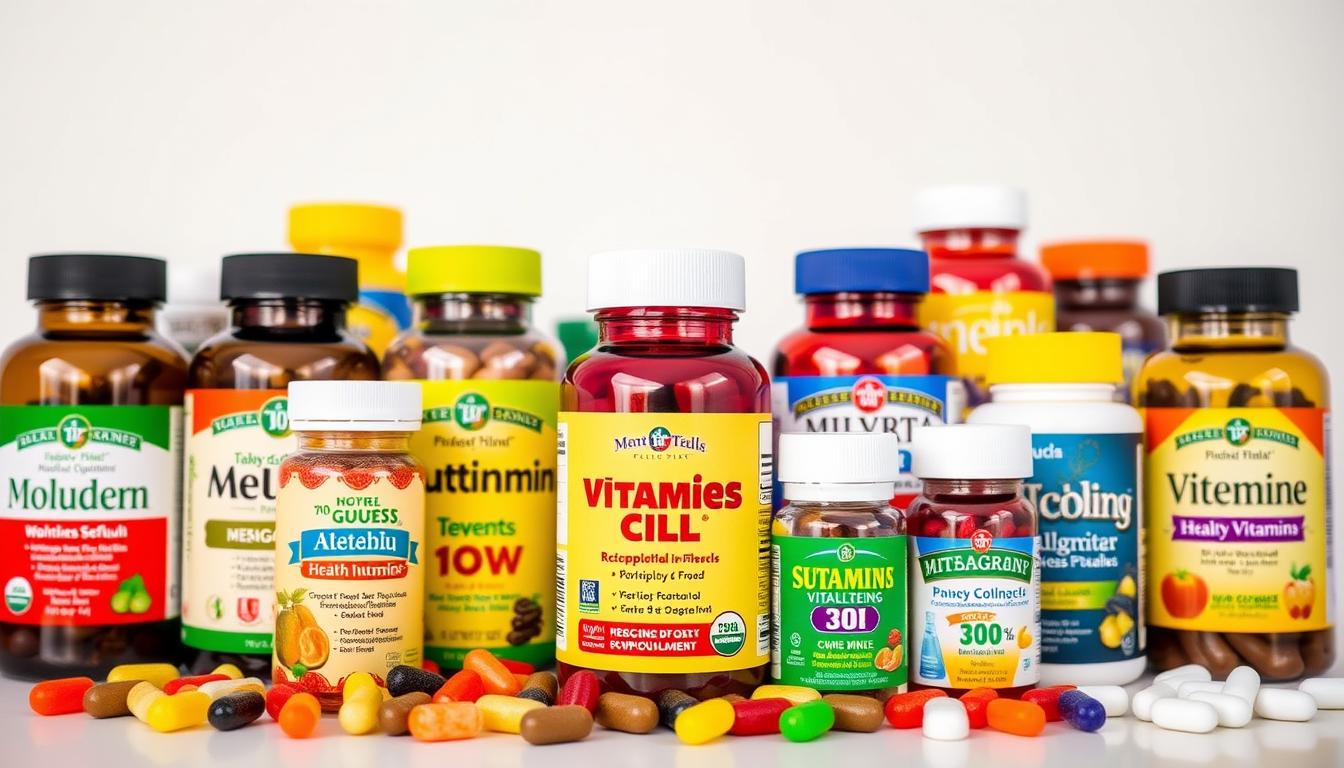
Prenatal Vitamin Options
Expectant mothers need special nutrients, mainly in early pregnancy. Many budget-friendly prenatal vitamins are available. But, it’s key to find ones with enough folic acid to prevent neural tube defects.
Folic Acid Requirements
The CDC says 600 mcg daily is needed for pregnant people. This is more than the usual adult dose. It’s important to find affordable options that meet this without going over 1,000 mcg.
- 34% of store-brand prenatal vitamins provided optimal 600-800 mcg ranges
- 12% contained potentially risky doses above 900 mcg
“Never assume prenatal formulas automatically meet folic acid guidelines – always verify labels against trimester-specific needs.”
Diabetic-Friendly Choices
For those with diabetes, picking the right multivitamin is key. Many cost-effective formulas use sugar alcohols as sweeteners. These can affect blood sugar and stomach comfort.
Sugar Alcohol Content
Ingredients like xylitol and sorbitol are low in sugar but can cause bloating. Here’s a comparison of safe options for diabetics:
| Sweetener | Glycemic Index | Cost Premium |
|---|---|---|
| Erythritol | 0 | +18% |
| Stevia | 0 | +22% |
| Maltitol | 35 | +5% |
For those watching their budget, erythritol-based options are best. They help keep blood sugar stable without upsetting the stomach, unlike cheaper choices.
Subscription Savings Analysis
Smart shoppers find great deals by using low-cost multivitamin selection subscriptions. You can save up to 25% a year without sacrificing quality. Let’s look at two ways to save: retail subscriptions and manufacturer loyalty clubs.
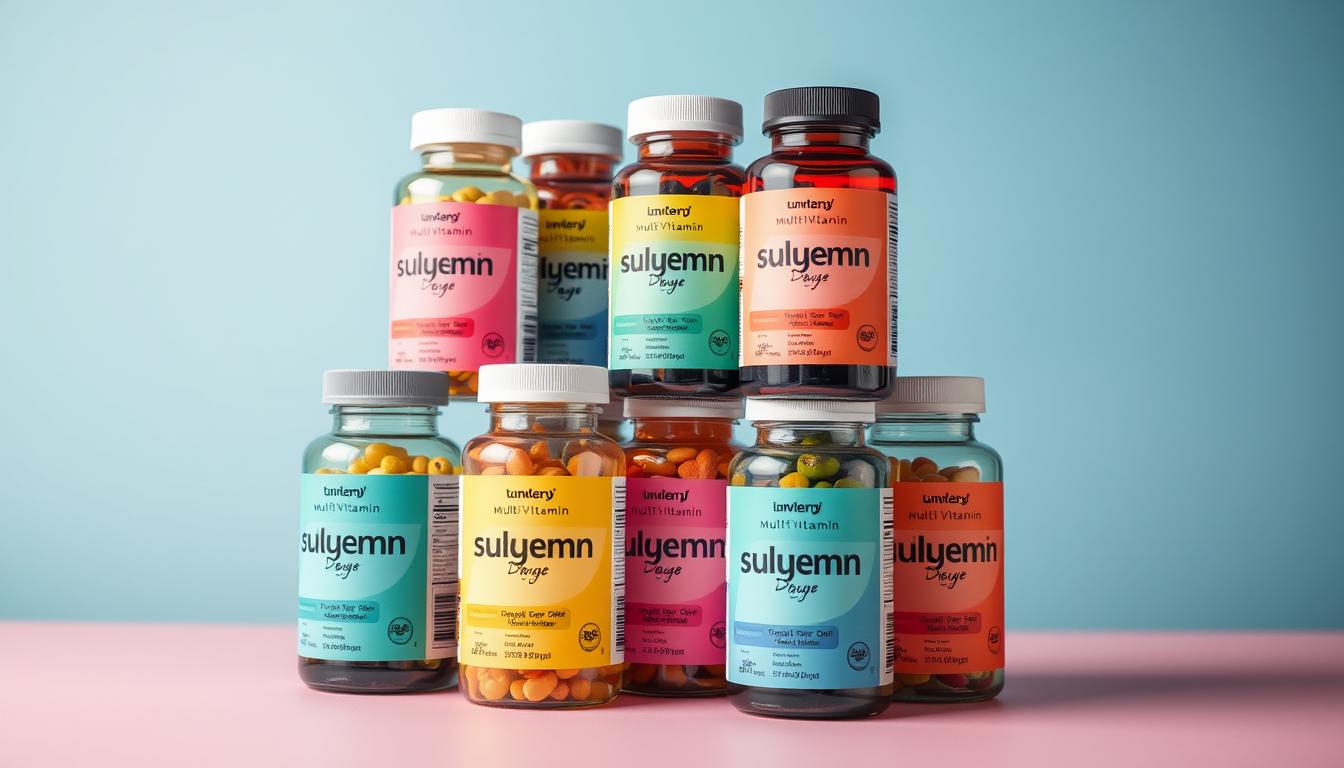
Amazon Subscribe & Save
Amazon’s program gives discounts based on how many subscriptions you have. Here’s how it works:
- 5% off for 1-4 recurring deliveries
- 10% off for 5+ subscriptions
- 15% discount for baby nutrition products
15% Discount Structure
Most multivitamins offer up to 10% off. But, you can save more by ordering more products. This is great for families needing several supplements.
Manufacturer Loyalty Programs
Brand-specific clubs, like the Centrum Advantage Club, reward loyal customers. Members get:
- Dollar-for-dollar reward points
- Birthday discounts
- Early access to new products
Centrum Advantage Club
Centrum’s program offers 20% off autoship orders, more than Amazon’s 15%. Plus, members get free nutrition guides. These guides help you choose the right low-cost multivitamin selection for you.
| Program | Max Discount | Extra Perks |
|---|---|---|
| Amazon Subscribe | 15% | Multi-product convenience |
| Centrum Club | 20% | Educational resources |
Go with Amazon for flexibility or choose manufacturer programs for deeper savings. Always check the price-per-serving. Some bulk deals might cost more than buying smaller amounts.
Common Budget Multivitamin Pitfalls
Finding an optimal budget multivitamin is more than just looking at prices. Many cheap options might not be good for your health or could be a waste of money. Let’s look at two big issues and how to steer clear of them.

Overdosing Risks in Multivitamins
Some cheap multivitamins have too much of certain nutrients. A 2023 study showed 12% of low-cost multivitamins had too much vitamin A. This can cause:
- Nausea and dizziness (short-term effects)
- Liver damage (chronic overconsumption)
- Increased fracture risk (vitamin A toxicity)
Vitamin A Toxicity Concerns
Vitamin A stored in body fat is a big risk. Always check the label for:
| Form | Safe Upper Limit | Common in Budget Brands? |
|---|---|---|
| Retinyl Palmitate | 3,000 mcg | Yes (84% of cases) |
| Beta-Carotene | No UL | Rare (16%) |
Bioavailability Oversights
Many cheap vitamins use forms that are hard for the body to use. For example, magnesium oxide is only 4% absorbed, while citrate is 90%. These choices make the vitamins less effective, even if they meet label claims.
Magnesium Forms Comparison
Not all magnesium is created equal. Here’s how different forms compare:
| Type | Absorption Rate | Cost per Dose | Best For |
|---|---|---|---|
| Oxide | 4% | $0.03 | Manufacturers |
| Citrate | 90% | $0.17 | Consumers |
| Glycinate | 80% | $0.22 | Sensitive Stomachs |
To avoid these problems, always check the ingredient forms against bioavailability charts. Look for third-party tested brands (like those with USP verification). They usually use better-absorbed compounds, even in more affordable options.
Expiration Date Realities
Expiration dates on multivitamins are not just suggestions. They are key to knowing when the nutrients start to lose their value. For affordable multivitamin brands, it’s even more critical. This is because they might cut costs by letting the vitamins lose potency faster.
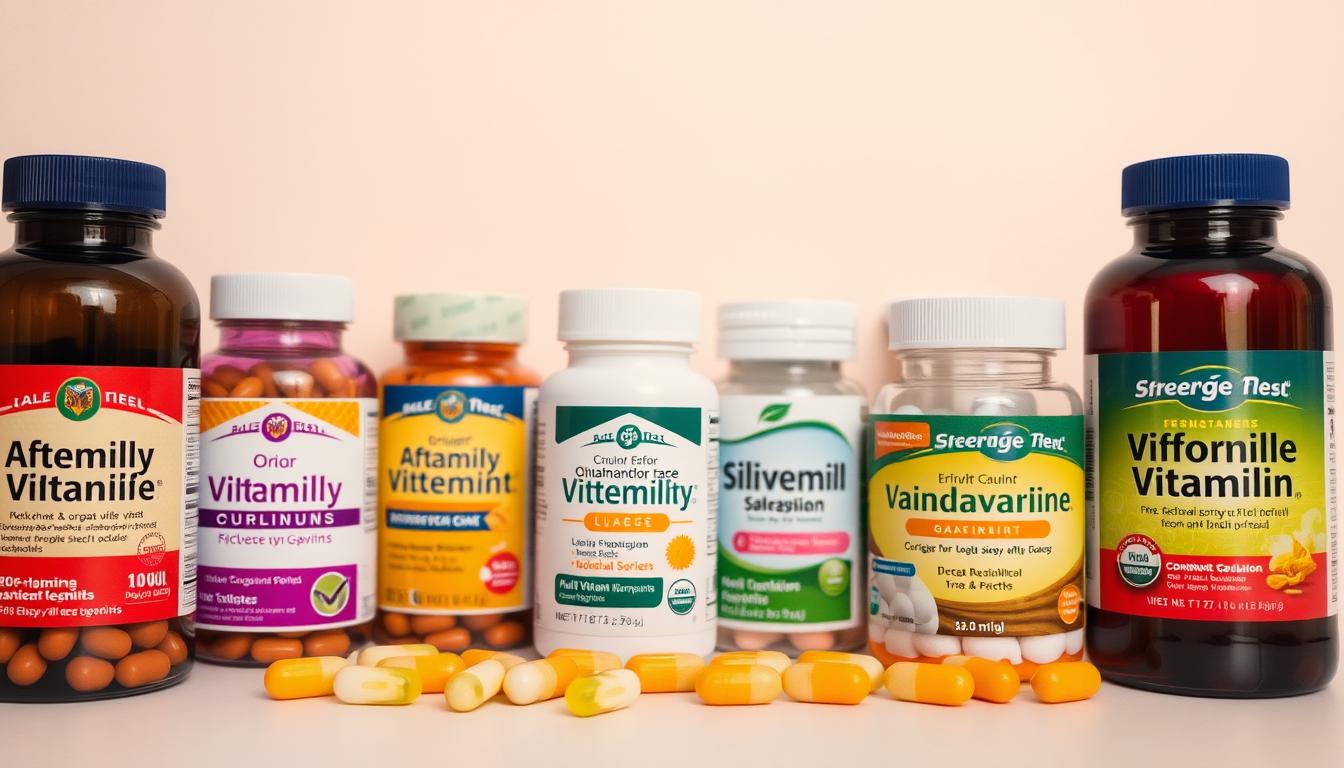
What Happens to Vitamins Over Time?
Supplements do break down, but at different rates. Research shows most nutrients keep 90% of their strength for 12 months after they’re made. But after 18 months, this number drops to 70%. Some vitamins can even disappear.
Vitamin C: The First to Fade
Vitamin C breaks down quickly. Studies show it loses 25% of its strength in just 6 months. Cheaper vitamins often don’t have the right additives to slow this down.
Bargain Bin Dangers
Clearance sections often have vitamins that are close to expiring. They might seem like a good deal, but they might not work as well. Source 3’s research shows some vitamins can lose 40% of their strength 3 months before they expire.
The 90-Day Rule for Discounted Stock
Always check the expiration date before buying clearance items. If it’s less than 3 months away:
- You might end up wasting vitamins
- They might not give you the nutrients you need
- It might not be a good deal after all
Good affordable multivitamin brands usually sell their stock faster. Try to buy from the makers themselves. They often promise their vitamins are fresh.
Final Purchasing Checklist
Before buying a multivitamin, check this list to ensure quality and value. We’ve made it easy by breaking it down into two main parts.
Quality Verification Steps
Third-party certification is key to finding good supplements. Look for these marks on the label:
- USP Verified (ensures purity and dissolution)
- NSF International Certified (tests for contaminants)
- ConsumerLab Approved (verifies ingredient accuracy)
It’s important to check the type of nutrients. Look for these:
- Vitamin D as D3 (cholecalciferol)
- Folate as methylfolate (not folic acid)
- Magnesium citrate or glycinate
Cost-Effectiveness Audit
Use this formula to find the best deal:
(Total tablets ÷ Daily serving size) × Price = Cost per month
A $15 bottle with 90 tablets (daily dose: 1 tablet) is better than a $10 bottle with 30 tablets. This is because it costs less per month ($5 vs $10). Always look for discounts and bulk prices before you buy.
Choose products that are tested well and priced fairly. The cheapest might not be the best, and the most expensive might not be worth it. Your best budget-friendly multivitamin will have high standards and a good price.
Making Smart Nutritional Investments
Finding good multivitamins that are affordable means looking for quality and value. Start by checking for USP-certified options like Nature Made or Centrum Silver. These brands offer high-quality supplements without breaking the bank.
Use a checklist to compare important factors like nutrient levels and price. It’s also key to look for third-party testing. This ensures the product is safe and effective.
Even the best multivitamins can’t replace a healthy diet. They should be seen as a supplement, not a replacement. This is important to remember, as noted in Source 1.
When shopping, pay attention to expiration dates and how to store them. This keeps the vitamins effective. Remember, multivitamins are best when used with a balanced diet and active lifestyle.
By following the steps in this article, you can find affordable vitamins that really help your health. Next, compare the top-rated options using the final checklist before you buy.
FAQ
How do I balance cost and quality when choosing a budget multivitamin?
FAQ
How do I balance cost and quality when choosing a budget multivitamin?
Look for USP-verified options like Nature Made or Kirkland Signature. They meet dissolution standards and cost less than
FAQ
How do I balance cost and quality when choosing a budget multivitamin?
Look for USP-verified options like Nature Made or Kirkland Signature. They meet dissolution standards and cost less than $0.30 per serving. Avoid calcium carbonate over citrate because it has 22% lower absorption, according to NIH research.
What are the risks of choosing ultra-low-cost multivitamins?
Cheap supplements often contain lead or have wrong dosages. Brands like Nature’s Bounty have faced lawsuits for vitamin D3 levels 400% below claims. Always check for NSF/UL certifications.
How can I identify my specific nutritional needs before buying?
Check CDC NHANES data—51% of Americans lack magnesium, 41% need vitamin D. Use Cronometer to track your diet for 72 hours. Look for persistent gaps in vitamin C, zinc, and folate where 30% of adults fall short.
Why does vitamin form matter in affordable multivitamins?
Synthetic dl-alpha tocopherol (vitamin E) costs $0.02/dose but has 50% lower bioavailability than natural d-alpha tocopherol. For vitamin K, MK-7 form provides 8-hour longer half-life than MK-4 despite 70% higher production costs.
Are store-brand multivitamins like CVS Health comparable to name brands?
Third-party testing shows CVS Gold Standard matches Centrum’s nutrient levels at 25% lower cost. But, their iron remains ferrous sulfate (18% absorption) vs premium brands’ ferrous bisglycinate (80% absorption).
How do I interpret "% Daily Value" on budget multivitamin labels?
FDA allows 20% variance in claimed nutrients. Target formulas providing 100-150% DV for vitamin D3, B12, and zinc—nutrients 42% of diets lack. Avoid products exceeding 200% DV for vitamin A due to toxicity risks.
What’s the real cost difference between tablets and vegetarian capsules?
Vegetarian capsules (NOW Foods) cost $0.18/dose vs $0.07 for tablets but prevent 23% nutrient degradation in digestion. Tablets require binders like magnesium stearate that can reduce absorption by 15%.
How long do discounted multivitamins remain potent after purchase?
Vitamin C degrades 27% faster in clear bottles (6-month potency loss vs 12 months in opaque containers). Check expiration dates—Spring Valley clearance items often have
Are prenatal vitamins worth the extra cost over regular multivitamins?
Yes—Nature Made Prenatal provides 1,000μg methylfolate (vs 400μg in standard multis) critical for fetal development. Budget options like Natalist lack choline, requiring separate $0.40/dose supplements.
What subscription model offers maximum savings on multivitamins?
Amazon Subscribe & Save provides 15% off Kirkland Signature (300-count for $22.45), beating Centrum’s loyalty program by $3.75/month. But, verify freshness—35% of subscribers report receiving supplements with
FAQ
How do I balance cost and quality when choosing a budget multivitamin?
Look for USP-verified options like Nature Made or Kirkland Signature. They meet dissolution standards and cost less than
FAQ
How do I balance cost and quality when choosing a budget multivitamin?
Look for USP-verified options like Nature Made or Kirkland Signature. They meet dissolution standards and cost less than $0.30 per serving. Avoid calcium carbonate over citrate because it has 22% lower absorption, according to NIH research.
What are the risks of choosing ultra-low-cost multivitamins?
Cheap supplements often contain lead or have wrong dosages. Brands like Nature’s Bounty have faced lawsuits for vitamin D3 levels 400% below claims. Always check for NSF/UL certifications.
How can I identify my specific nutritional needs before buying?
Check CDC NHANES data—51% of Americans lack magnesium, 41% need vitamin D. Use Cronometer to track your diet for 72 hours. Look for persistent gaps in vitamin C, zinc, and folate where 30% of adults fall short.
Why does vitamin form matter in affordable multivitamins?
Synthetic dl-alpha tocopherol (vitamin E) costs $0.02/dose but has 50% lower bioavailability than natural d-alpha tocopherol. For vitamin K, MK-7 form provides 8-hour longer half-life than MK-4 despite 70% higher production costs.
Are store-brand multivitamins like CVS Health comparable to name brands?
Third-party testing shows CVS Gold Standard matches Centrum’s nutrient levels at 25% lower cost. But, their iron remains ferrous sulfate (18% absorption) vs premium brands’ ferrous bisglycinate (80% absorption).
How do I interpret "% Daily Value" on budget multivitamin labels?
FDA allows 20% variance in claimed nutrients. Target formulas providing 100-150% DV for vitamin D3, B12, and zinc—nutrients 42% of diets lack. Avoid products exceeding 200% DV for vitamin A due to toxicity risks.
What’s the real cost difference between tablets and vegetarian capsules?
Vegetarian capsules (NOW Foods) cost $0.18/dose vs $0.07 for tablets but prevent 23% nutrient degradation in digestion. Tablets require binders like magnesium stearate that can reduce absorption by 15%.
How long do discounted multivitamins remain potent after purchase?
Vitamin C degrades 27% faster in clear bottles (6-month potency loss vs 12 months in opaque containers). Check expiration dates—Spring Valley clearance items often have
Are prenatal vitamins worth the extra cost over regular multivitamins?
Yes—Nature Made Prenatal provides 1,000μg methylfolate (vs 400μg in standard multis) critical for fetal development. Budget options like Natalist lack choline, requiring separate $0.40/dose supplements.
What subscription model offers maximum savings on multivitamins?
Amazon Subscribe & Save provides 15% off Kirkland Signature (300-count for $22.45), beating Centrum’s loyalty program by $3.75/month. But, verify freshness—35% of subscribers report receiving supplements with
FAQ
How do I balance cost and quality when choosing a budget multivitamin?
Look for USP-verified options like Nature Made or Kirkland Signature. They meet dissolution standards and cost less than
FAQ
How do I balance cost and quality when choosing a budget multivitamin?
Look for USP-verified options like Nature Made or Kirkland Signature. They meet dissolution standards and cost less than $0.30 per serving. Avoid calcium carbonate over citrate because it has 22% lower absorption, according to NIH research.
What are the risks of choosing ultra-low-cost multivitamins?
Cheap supplements often contain lead or have wrong dosages. Brands like Nature’s Bounty have faced lawsuits for vitamin D3 levels 400% below claims. Always check for NSF/UL certifications.
How can I identify my specific nutritional needs before buying?
Check CDC NHANES data—51% of Americans lack magnesium, 41% need vitamin D. Use Cronometer to track your diet for 72 hours. Look for persistent gaps in vitamin C, zinc, and folate where 30% of adults fall short.
Why does vitamin form matter in affordable multivitamins?
Synthetic dl-alpha tocopherol (vitamin E) costs $0.02/dose but has 50% lower bioavailability than natural d-alpha tocopherol. For vitamin K, MK-7 form provides 8-hour longer half-life than MK-4 despite 70% higher production costs.
Are store-brand multivitamins like CVS Health comparable to name brands?
Third-party testing shows CVS Gold Standard matches Centrum’s nutrient levels at 25% lower cost. But, their iron remains ferrous sulfate (18% absorption) vs premium brands’ ferrous bisglycinate (80% absorption).
How do I interpret "% Daily Value" on budget multivitamin labels?
FDA allows 20% variance in claimed nutrients. Target formulas providing 100-150% DV for vitamin D3, B12, and zinc—nutrients 42% of diets lack. Avoid products exceeding 200% DV for vitamin A due to toxicity risks.
What’s the real cost difference between tablets and vegetarian capsules?
Vegetarian capsules (NOW Foods) cost $0.18/dose vs $0.07 for tablets but prevent 23% nutrient degradation in digestion. Tablets require binders like magnesium stearate that can reduce absorption by 15%.
How long do discounted multivitamins remain potent after purchase?
Vitamin C degrades 27% faster in clear bottles (6-month potency loss vs 12 months in opaque containers). Check expiration dates—Spring Valley clearance items often have
Are prenatal vitamins worth the extra cost over regular multivitamins?
Yes—Nature Made Prenatal provides 1,000μg methylfolate (vs 400μg in standard multis) critical for fetal development. Budget options like Natalist lack choline, requiring separate $0.40/dose supplements.
What subscription model offers maximum savings on multivitamins?
Amazon Subscribe & Save provides 15% off Kirkland Signature (300-count for $22.45), beating Centrum’s loyalty program by $3.75/month. But, verify freshness—35% of subscribers report receiving supplements with
FAQ
How do I balance cost and quality when choosing a budget multivitamin?
Look for USP-verified options like Nature Made or Kirkland Signature. They meet dissolution standards and cost less than
FAQ
How do I balance cost and quality when choosing a budget multivitamin?
Look for USP-verified options like Nature Made or Kirkland Signature. They meet dissolution standards and cost less than $0.30 per serving. Avoid calcium carbonate over citrate because it has 22% lower absorption, according to NIH research.
What are the risks of choosing ultra-low-cost multivitamins?
Cheap supplements often contain lead or have wrong dosages. Brands like Nature’s Bounty have faced lawsuits for vitamin D3 levels 400% below claims. Always check for NSF/UL certifications.
How can I identify my specific nutritional needs before buying?
Check CDC NHANES data—51% of Americans lack magnesium, 41% need vitamin D. Use Cronometer to track your diet for 72 hours. Look for persistent gaps in vitamin C, zinc, and folate where 30% of adults fall short.
Why does vitamin form matter in affordable multivitamins?
Synthetic dl-alpha tocopherol (vitamin E) costs $0.02/dose but has 50% lower bioavailability than natural d-alpha tocopherol. For vitamin K, MK-7 form provides 8-hour longer half-life than MK-4 despite 70% higher production costs.
Are store-brand multivitamins like CVS Health comparable to name brands?
Third-party testing shows CVS Gold Standard matches Centrum’s nutrient levels at 25% lower cost. But, their iron remains ferrous sulfate (18% absorption) vs premium brands’ ferrous bisglycinate (80% absorption).
How do I interpret "% Daily Value" on budget multivitamin labels?
FDA allows 20% variance in claimed nutrients. Target formulas providing 100-150% DV for vitamin D3, B12, and zinc—nutrients 42% of diets lack. Avoid products exceeding 200% DV for vitamin A due to toxicity risks.
What’s the real cost difference between tablets and vegetarian capsules?
Vegetarian capsules (NOW Foods) cost $0.18/dose vs $0.07 for tablets but prevent 23% nutrient degradation in digestion. Tablets require binders like magnesium stearate that can reduce absorption by 15%.
How long do discounted multivitamins remain potent after purchase?
Vitamin C degrades 27% faster in clear bottles (6-month potency loss vs 12 months in opaque containers). Check expiration dates—Spring Valley clearance items often have
Are prenatal vitamins worth the extra cost over regular multivitamins?
Yes—Nature Made Prenatal provides 1,000μg methylfolate (vs 400μg in standard multis) critical for fetal development. Budget options like Natalist lack choline, requiring separate $0.40/dose supplements.
What subscription model offers maximum savings on multivitamins?
Amazon Subscribe & Save provides 15% off Kirkland Signature (300-count for $22.45), beating Centrum’s loyalty program by $3.75/month. But, verify freshness—35% of subscribers report receiving supplements with
FAQ
How do I balance cost and quality when choosing a budget multivitamin?
Look for USP-verified options like Nature Made or Kirkland Signature. They meet dissolution standards and cost less than
FAQ
How do I balance cost and quality when choosing a budget multivitamin?
Look for USP-verified options like Nature Made or Kirkland Signature. They meet dissolution standards and cost less than $0.30 per serving. Avoid calcium carbonate over citrate because it has 22% lower absorption, according to NIH research.
What are the risks of choosing ultra-low-cost multivitamins?
Cheap supplements often contain lead or have wrong dosages. Brands like Nature’s Bounty have faced lawsuits for vitamin D3 levels 400% below claims. Always check for NSF/UL certifications.
How can I identify my specific nutritional needs before buying?
Check CDC NHANES data—51% of Americans lack magnesium, 41% need vitamin D. Use Cronometer to track your diet for 72 hours. Look for persistent gaps in vitamin C, zinc, and folate where 30% of adults fall short.
Why does vitamin form matter in affordable multivitamins?
Synthetic dl-alpha tocopherol (vitamin E) costs $0.02/dose but has 50% lower bioavailability than natural d-alpha tocopherol. For vitamin K, MK-7 form provides 8-hour longer half-life than MK-4 despite 70% higher production costs.
Are store-brand multivitamins like CVS Health comparable to name brands?
Third-party testing shows CVS Gold Standard matches Centrum’s nutrient levels at 25% lower cost. But, their iron remains ferrous sulfate (18% absorption) vs premium brands’ ferrous bisglycinate (80% absorption).
How do I interpret "% Daily Value" on budget multivitamin labels?
FDA allows 20% variance in claimed nutrients. Target formulas providing 100-150% DV for vitamin D3, B12, and zinc—nutrients 42% of diets lack. Avoid products exceeding 200% DV for vitamin A due to toxicity risks.
What’s the real cost difference between tablets and vegetarian capsules?
Vegetarian capsules (NOW Foods) cost $0.18/dose vs $0.07 for tablets but prevent 23% nutrient degradation in digestion. Tablets require binders like magnesium stearate that can reduce absorption by 15%.
How long do discounted multivitamins remain potent after purchase?
Vitamin C degrades 27% faster in clear bottles (6-month potency loss vs 12 months in opaque containers). Check expiration dates—Spring Valley clearance items often have
Are prenatal vitamins worth the extra cost over regular multivitamins?
Yes—Nature Made Prenatal provides 1,000μg methylfolate (vs 400μg in standard multis) critical for fetal development. Budget options like Natalist lack choline, requiring separate $0.40/dose supplements.
What subscription model offers maximum savings on multivitamins?
Amazon Subscribe & Save provides 15% off Kirkland Signature (300-count for $22.45), beating Centrum’s loyalty program by $3.75/month. But, verify freshness—35% of subscribers report receiving supplements with
.30 per serving. Avoid calcium carbonate over citrate because it has 22% lower absorption, according to NIH research.
What are the risks of choosing ultra-low-cost multivitamins?
Cheap supplements often contain lead or have wrong dosages. Brands like Nature’s Bounty have faced lawsuits for vitamin D3 levels 400% below claims. Always check for NSF/UL certifications.
How can I identify my specific nutritional needs before buying?
Check CDC NHANES data—51% of Americans lack magnesium, 41% need vitamin D. Use Cronometer to track your diet for 72 hours. Look for persistent gaps in vitamin C, zinc, and folate where 30% of adults fall short.
Why does vitamin form matter in affordable multivitamins?
Synthetic dl-alpha tocopherol (vitamin E) costs
FAQ
How do I balance cost and quality when choosing a budget multivitamin?
Look for USP-verified options like Nature Made or Kirkland Signature. They meet dissolution standards and cost less than $0.30 per serving. Avoid calcium carbonate over citrate because it has 22% lower absorption, according to NIH research.
What are the risks of choosing ultra-low-cost multivitamins?
Cheap supplements often contain lead or have wrong dosages. Brands like Nature’s Bounty have faced lawsuits for vitamin D3 levels 400% below claims. Always check for NSF/UL certifications.
How can I identify my specific nutritional needs before buying?
Check CDC NHANES data—51% of Americans lack magnesium, 41% need vitamin D. Use Cronometer to track your diet for 72 hours. Look for persistent gaps in vitamin C, zinc, and folate where 30% of adults fall short.
Why does vitamin form matter in affordable multivitamins?
Synthetic dl-alpha tocopherol (vitamin E) costs $0.02/dose but has 50% lower bioavailability than natural d-alpha tocopherol. For vitamin K, MK-7 form provides 8-hour longer half-life than MK-4 despite 70% higher production costs.
Are store-brand multivitamins like CVS Health comparable to name brands?
Third-party testing shows CVS Gold Standard matches Centrum’s nutrient levels at 25% lower cost. But, their iron remains ferrous sulfate (18% absorption) vs premium brands’ ferrous bisglycinate (80% absorption).
How do I interpret "% Daily Value" on budget multivitamin labels?
FDA allows 20% variance in claimed nutrients. Target formulas providing 100-150% DV for vitamin D3, B12, and zinc—nutrients 42% of diets lack. Avoid products exceeding 200% DV for vitamin A due to toxicity risks.
What’s the real cost difference between tablets and vegetarian capsules?
Vegetarian capsules (NOW Foods) cost $0.18/dose vs $0.07 for tablets but prevent 23% nutrient degradation in digestion. Tablets require binders like magnesium stearate that can reduce absorption by 15%.
How long do discounted multivitamins remain potent after purchase?
Vitamin C degrades 27% faster in clear bottles (6-month potency loss vs 12 months in opaque containers). Check expiration dates—Spring Valley clearance items often have
Are prenatal vitamins worth the extra cost over regular multivitamins?
Yes—Nature Made Prenatal provides 1,000μg methylfolate (vs 400μg in standard multis) critical for fetal development. Budget options like Natalist lack choline, requiring separate $0.40/dose supplements.
What subscription model offers maximum savings on multivitamins?
Amazon Subscribe & Save provides 15% off Kirkland Signature (300-count for $22.45), beating Centrum’s loyalty program by $3.75/month. But, verify freshness—35% of subscribers report receiving supplements with
.02/dose but has 50% lower bioavailability than natural d-alpha tocopherol. For vitamin K, MK-7 form provides 8-hour longer half-life than MK-4 despite 70% higher production costs.
Are store-brand multivitamins like CVS Health comparable to name brands?
Third-party testing shows CVS Gold Standard matches Centrum’s nutrient levels at 25% lower cost. But, their iron remains ferrous sulfate (18% absorption) vs premium brands’ ferrous bisglycinate (80% absorption).
How do I interpret "% Daily Value" on budget multivitamin labels?
FDA allows 20% variance in claimed nutrients. Target formulas providing 100-150% DV for vitamin D3, B12, and zinc—nutrients 42% of diets lack. Avoid products exceeding 200% DV for vitamin A due to toxicity risks.
What’s the real cost difference between tablets and vegetarian capsules?
Vegetarian capsules (NOW Foods) cost
FAQ
How do I balance cost and quality when choosing a budget multivitamin?
Look for USP-verified options like Nature Made or Kirkland Signature. They meet dissolution standards and cost less than $0.30 per serving. Avoid calcium carbonate over citrate because it has 22% lower absorption, according to NIH research.
What are the risks of choosing ultra-low-cost multivitamins?
Cheap supplements often contain lead or have wrong dosages. Brands like Nature’s Bounty have faced lawsuits for vitamin D3 levels 400% below claims. Always check for NSF/UL certifications.
How can I identify my specific nutritional needs before buying?
Check CDC NHANES data—51% of Americans lack magnesium, 41% need vitamin D. Use Cronometer to track your diet for 72 hours. Look for persistent gaps in vitamin C, zinc, and folate where 30% of adults fall short.
Why does vitamin form matter in affordable multivitamins?
Synthetic dl-alpha tocopherol (vitamin E) costs $0.02/dose but has 50% lower bioavailability than natural d-alpha tocopherol. For vitamin K, MK-7 form provides 8-hour longer half-life than MK-4 despite 70% higher production costs.
Are store-brand multivitamins like CVS Health comparable to name brands?
Third-party testing shows CVS Gold Standard matches Centrum’s nutrient levels at 25% lower cost. But, their iron remains ferrous sulfate (18% absorption) vs premium brands’ ferrous bisglycinate (80% absorption).
How do I interpret "% Daily Value" on budget multivitamin labels?
FDA allows 20% variance in claimed nutrients. Target formulas providing 100-150% DV for vitamin D3, B12, and zinc—nutrients 42% of diets lack. Avoid products exceeding 200% DV for vitamin A due to toxicity risks.
What’s the real cost difference between tablets and vegetarian capsules?
Vegetarian capsules (NOW Foods) cost $0.18/dose vs $0.07 for tablets but prevent 23% nutrient degradation in digestion. Tablets require binders like magnesium stearate that can reduce absorption by 15%.
How long do discounted multivitamins remain potent after purchase?
Vitamin C degrades 27% faster in clear bottles (6-month potency loss vs 12 months in opaque containers). Check expiration dates—Spring Valley clearance items often have
Are prenatal vitamins worth the extra cost over regular multivitamins?
Yes—Nature Made Prenatal provides 1,000μg methylfolate (vs 400μg in standard multis) critical for fetal development. Budget options like Natalist lack choline, requiring separate $0.40/dose supplements.
What subscription model offers maximum savings on multivitamins?
Amazon Subscribe & Save provides 15% off Kirkland Signature (300-count for $22.45), beating Centrum’s loyalty program by $3.75/month. But, verify freshness—35% of subscribers report receiving supplements with
.18/dose vs
FAQ
How do I balance cost and quality when choosing a budget multivitamin?
Look for USP-verified options like Nature Made or Kirkland Signature. They meet dissolution standards and cost less than $0.30 per serving. Avoid calcium carbonate over citrate because it has 22% lower absorption, according to NIH research.
What are the risks of choosing ultra-low-cost multivitamins?
Cheap supplements often contain lead or have wrong dosages. Brands like Nature’s Bounty have faced lawsuits for vitamin D3 levels 400% below claims. Always check for NSF/UL certifications.
How can I identify my specific nutritional needs before buying?
Check CDC NHANES data—51% of Americans lack magnesium, 41% need vitamin D. Use Cronometer to track your diet for 72 hours. Look for persistent gaps in vitamin C, zinc, and folate where 30% of adults fall short.
Why does vitamin form matter in affordable multivitamins?
Synthetic dl-alpha tocopherol (vitamin E) costs $0.02/dose but has 50% lower bioavailability than natural d-alpha tocopherol. For vitamin K, MK-7 form provides 8-hour longer half-life than MK-4 despite 70% higher production costs.
Are store-brand multivitamins like CVS Health comparable to name brands?
Third-party testing shows CVS Gold Standard matches Centrum’s nutrient levels at 25% lower cost. But, their iron remains ferrous sulfate (18% absorption) vs premium brands’ ferrous bisglycinate (80% absorption).
How do I interpret "% Daily Value" on budget multivitamin labels?
FDA allows 20% variance in claimed nutrients. Target formulas providing 100-150% DV for vitamin D3, B12, and zinc—nutrients 42% of diets lack. Avoid products exceeding 200% DV for vitamin A due to toxicity risks.
What’s the real cost difference between tablets and vegetarian capsules?
Vegetarian capsules (NOW Foods) cost $0.18/dose vs $0.07 for tablets but prevent 23% nutrient degradation in digestion. Tablets require binders like magnesium stearate that can reduce absorption by 15%.
How long do discounted multivitamins remain potent after purchase?
Vitamin C degrades 27% faster in clear bottles (6-month potency loss vs 12 months in opaque containers). Check expiration dates—Spring Valley clearance items often have
Are prenatal vitamins worth the extra cost over regular multivitamins?
Yes—Nature Made Prenatal provides 1,000μg methylfolate (vs 400μg in standard multis) critical for fetal development. Budget options like Natalist lack choline, requiring separate $0.40/dose supplements.
What subscription model offers maximum savings on multivitamins?
Amazon Subscribe & Save provides 15% off Kirkland Signature (300-count for $22.45), beating Centrum’s loyalty program by $3.75/month. But, verify freshness—35% of subscribers report receiving supplements with
.07 for tablets but prevent 23% nutrient degradation in digestion. Tablets require binders like magnesium stearate that can reduce absorption by 15%.
How long do discounted multivitamins remain potent after purchase?
Vitamin C degrades 27% faster in clear bottles (6-month potency loss vs 12 months in opaque containers). Check expiration dates—Spring Valley clearance items often have
Are prenatal vitamins worth the extra cost over regular multivitamins?
Yes—Nature Made Prenatal provides 1,000μg methylfolate (vs 400μg in standard multis) critical for fetal development. Budget options like Natalist lack choline, requiring separate
FAQ
How do I balance cost and quality when choosing a budget multivitamin?
Look for USP-verified options like Nature Made or Kirkland Signature. They meet dissolution standards and cost less than $0.30 per serving. Avoid calcium carbonate over citrate because it has 22% lower absorption, according to NIH research.
What are the risks of choosing ultra-low-cost multivitamins?
Cheap supplements often contain lead or have wrong dosages. Brands like Nature’s Bounty have faced lawsuits for vitamin D3 levels 400% below claims. Always check for NSF/UL certifications.
How can I identify my specific nutritional needs before buying?
Check CDC NHANES data—51% of Americans lack magnesium, 41% need vitamin D. Use Cronometer to track your diet for 72 hours. Look for persistent gaps in vitamin C, zinc, and folate where 30% of adults fall short.
Why does vitamin form matter in affordable multivitamins?
Synthetic dl-alpha tocopherol (vitamin E) costs $0.02/dose but has 50% lower bioavailability than natural d-alpha tocopherol. For vitamin K, MK-7 form provides 8-hour longer half-life than MK-4 despite 70% higher production costs.
Are store-brand multivitamins like CVS Health comparable to name brands?
Third-party testing shows CVS Gold Standard matches Centrum’s nutrient levels at 25% lower cost. But, their iron remains ferrous sulfate (18% absorption) vs premium brands’ ferrous bisglycinate (80% absorption).
How do I interpret "% Daily Value" on budget multivitamin labels?
FDA allows 20% variance in claimed nutrients. Target formulas providing 100-150% DV for vitamin D3, B12, and zinc—nutrients 42% of diets lack. Avoid products exceeding 200% DV for vitamin A due to toxicity risks.
What’s the real cost difference between tablets and vegetarian capsules?
Vegetarian capsules (NOW Foods) cost $0.18/dose vs $0.07 for tablets but prevent 23% nutrient degradation in digestion. Tablets require binders like magnesium stearate that can reduce absorption by 15%.
How long do discounted multivitamins remain potent after purchase?
Vitamin C degrades 27% faster in clear bottles (6-month potency loss vs 12 months in opaque containers). Check expiration dates—Spring Valley clearance items often have
Are prenatal vitamins worth the extra cost over regular multivitamins?
Yes—Nature Made Prenatal provides 1,000μg methylfolate (vs 400μg in standard multis) critical for fetal development. Budget options like Natalist lack choline, requiring separate $0.40/dose supplements.
What subscription model offers maximum savings on multivitamins?
Amazon Subscribe & Save provides 15% off Kirkland Signature (300-count for $22.45), beating Centrum’s loyalty program by $3.75/month. But, verify freshness—35% of subscribers report receiving supplements with
.40/dose supplements.
What subscription model offers maximum savings on multivitamins?
Amazon Subscribe & Save provides 15% off Kirkland Signature (300-count for .45), beating Centrum’s loyalty program by .75/month. But, verify freshness—35% of subscribers report receiving supplements with